Discrete Mathematics Assignment: Closed Formulas and L-Structure
VerifiedAdded on 2020/04/15
|9
|2209
|466
Homework Assignment
AI Summary
This document presents a comprehensive solution to a Discrete Mathematics assignment. The solution begins by addressing axioms and closed formulas within a given language (L), exploring the properties of L-structures. It delves into first-order logic, including proofs and the removal of certain conditions. The assignment further examines L-structures concerning real numbers and explores concepts of countability and infinity within set theory, providing proofs and examples. The solution concludes by analyzing the intersection of sets and their properties. The assignment demonstrates a strong understanding of discrete mathematical concepts, logical reasoning, and proof techniques, referencing relevant literature to support its findings.
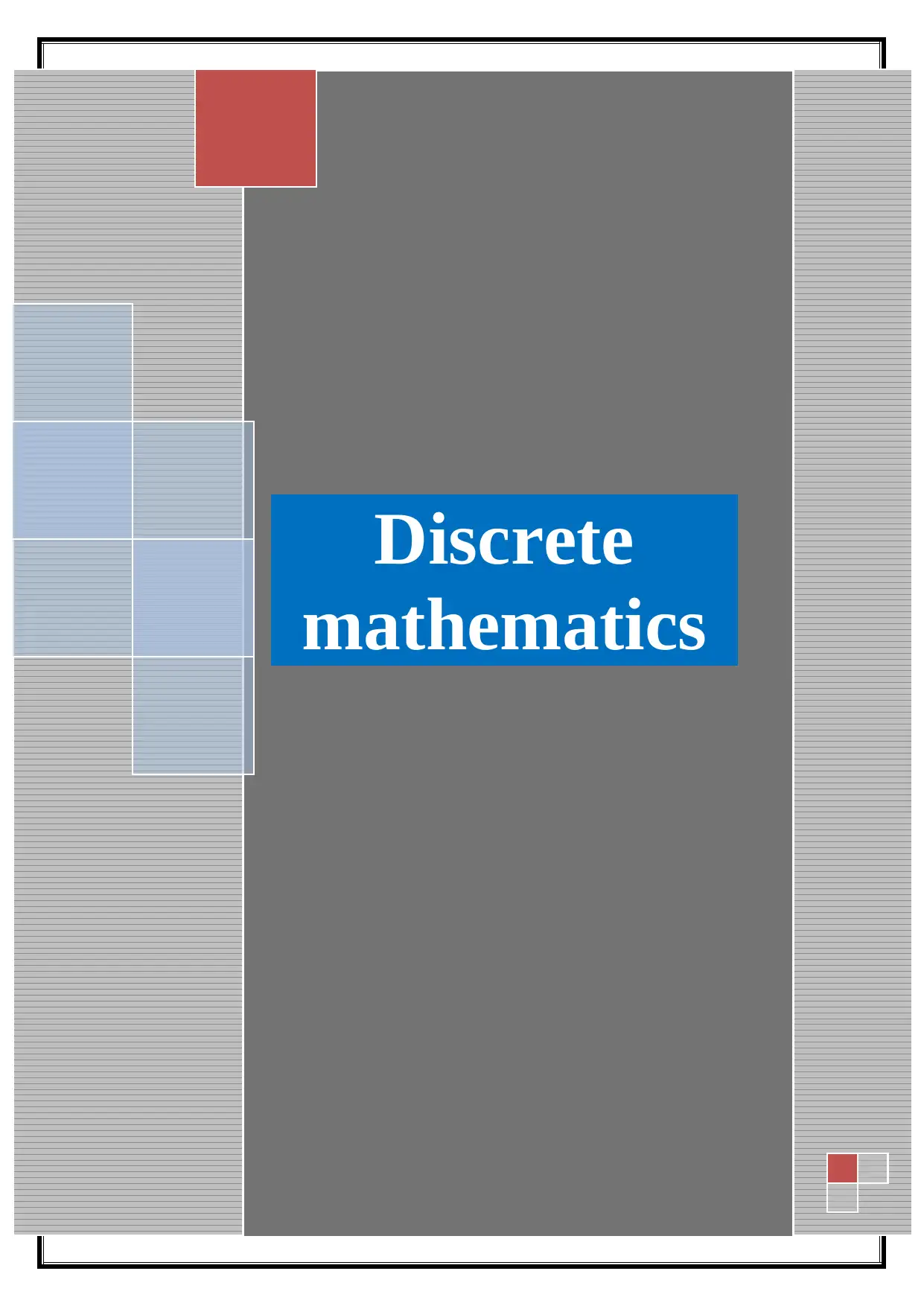
Discrete
mathematics
mathematics
Paraphrase This Document
Need a fresh take? Get an instant paraphrase of this document with our AI Paraphraser
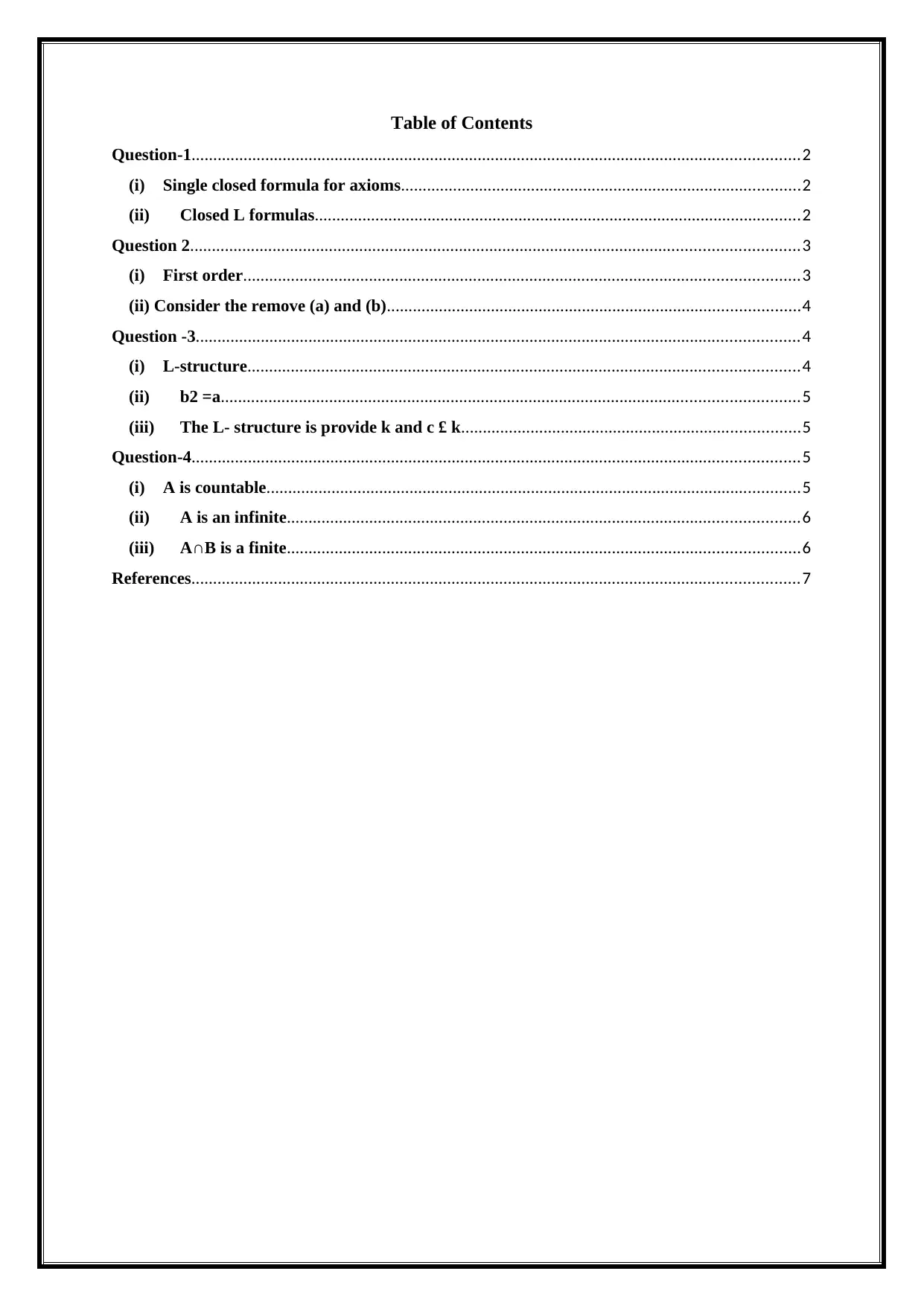
Table of Contents
Question-1............................................................................................................................................2
(i) Single closed formula for axioms............................................................................................2
(ii) Closed L formulas................................................................................................................2
Question 2............................................................................................................................................3
(i) First order................................................................................................................................3
(ii) Consider the remove (a) and (b)...............................................................................................4
Question -3...........................................................................................................................................4
(i) L-structure...............................................................................................................................4
(ii) b2 =a.....................................................................................................................................5
(iii) The L- structure is provide k and c £ k..............................................................................5
Question-4............................................................................................................................................5
(i) A is countable...........................................................................................................................5
(ii) A is an infinite......................................................................................................................6
(iii) A∩B is a finite......................................................................................................................6
References............................................................................................................................................7
Question-1............................................................................................................................................2
(i) Single closed formula for axioms............................................................................................2
(ii) Closed L formulas................................................................................................................2
Question 2............................................................................................................................................3
(i) First order................................................................................................................................3
(ii) Consider the remove (a) and (b)...............................................................................................4
Question -3...........................................................................................................................................4
(i) L-structure...............................................................................................................................4
(ii) b2 =a.....................................................................................................................................5
(iii) The L- structure is provide k and c £ k..............................................................................5
Question-4............................................................................................................................................5
(i) A is countable...........................................................................................................................5
(ii) A is an infinite......................................................................................................................6
(iii) A∩B is a finite......................................................................................................................6
References............................................................................................................................................7
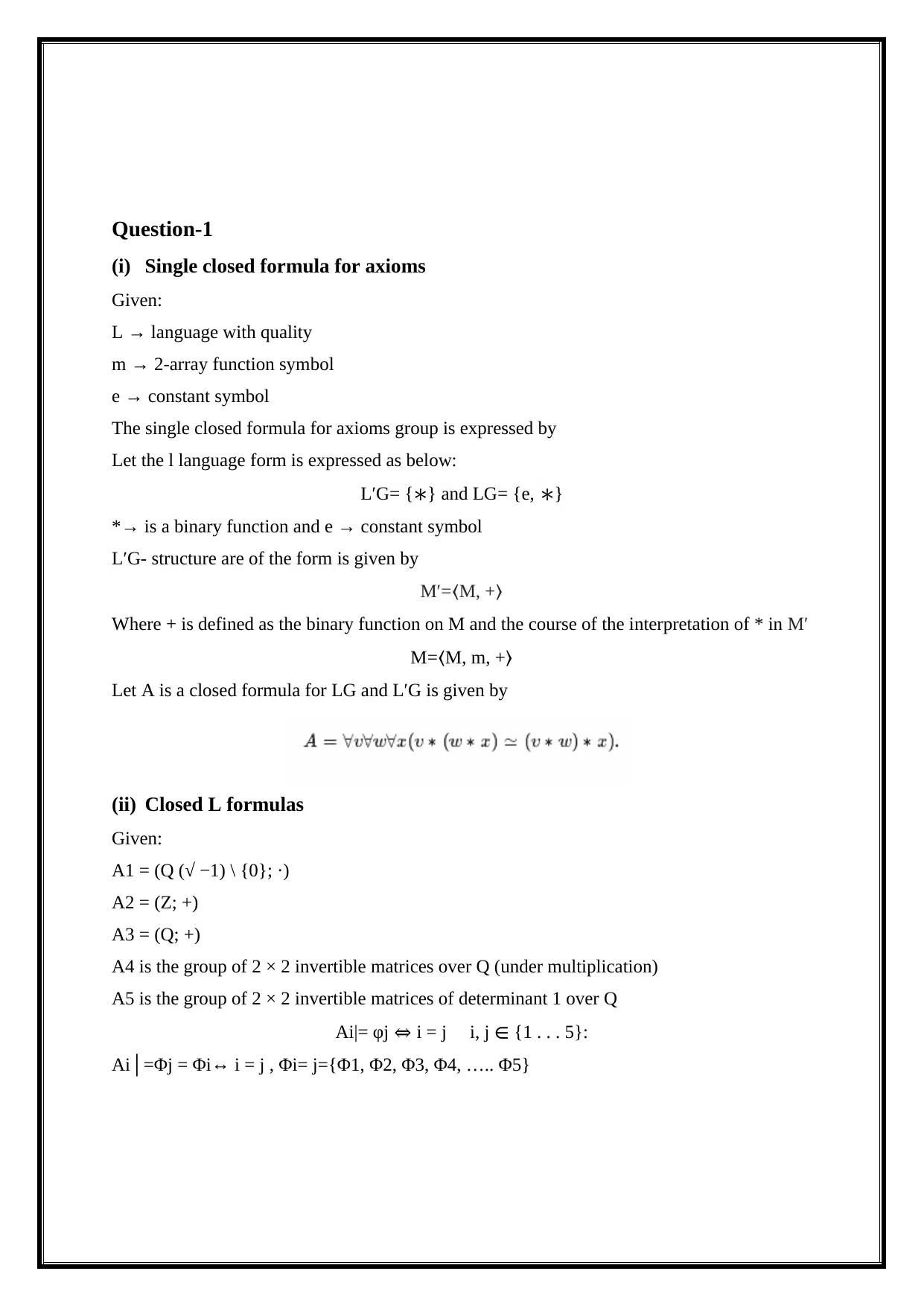
Question-1
(i) Single closed formula for axioms
Given:
L → language with quality
m → 2-array function symbol
e → constant symbol
The single closed formula for axioms group is expressed by
Let the l language form is expressed as below:
L′G= {∗} and LG= {e, ∗}
*→ is a binary function and e → constant symbol
L′G- structure are of the form is given by
M′=⟨M, +⟩
Where + is defined as the binary function on M and the course of the interpretation of * in M′
M=⟨M, m, +⟩
Let A is a closed formula for LG and L′G is given by
(ii) Closed L formulas
Given:
A1 = (Q (√ −1) \ {0}; ·)
A2 = (Z; +)
A3 = (Q; +)
A4 is the group of 2 × 2 invertible matrices over Q (under multiplication)
A5 is the group of 2 × 2 invertible matrices of determinant 1 over Q
Ai|= φj ⇔ i = j i, j ∈ {1 . . . 5}:
Ai│=Φj = Φi ↔ i = j , Φi= j={Φ1, Φ2, Φ3, Φ4, ….. Φ5}
(i) Single closed formula for axioms
Given:
L → language with quality
m → 2-array function symbol
e → constant symbol
The single closed formula for axioms group is expressed by
Let the l language form is expressed as below:
L′G= {∗} and LG= {e, ∗}
*→ is a binary function and e → constant symbol
L′G- structure are of the form is given by
M′=⟨M, +⟩
Where + is defined as the binary function on M and the course of the interpretation of * in M′
M=⟨M, m, +⟩
Let A is a closed formula for LG and L′G is given by
(ii) Closed L formulas
Given:
A1 = (Q (√ −1) \ {0}; ·)
A2 = (Z; +)
A3 = (Q; +)
A4 is the group of 2 × 2 invertible matrices over Q (under multiplication)
A5 is the group of 2 × 2 invertible matrices of determinant 1 over Q
Ai|= φj ⇔ i = j i, j ∈ {1 . . . 5}:
Ai│=Φj = Φi ↔ i = j , Φi= j={Φ1, Φ2, Φ3, Φ4, ….. Φ5}
⊘ This is a preview!⊘
Do you want full access?
Subscribe today to unlock all pages.

Trusted by 1+ million students worldwide
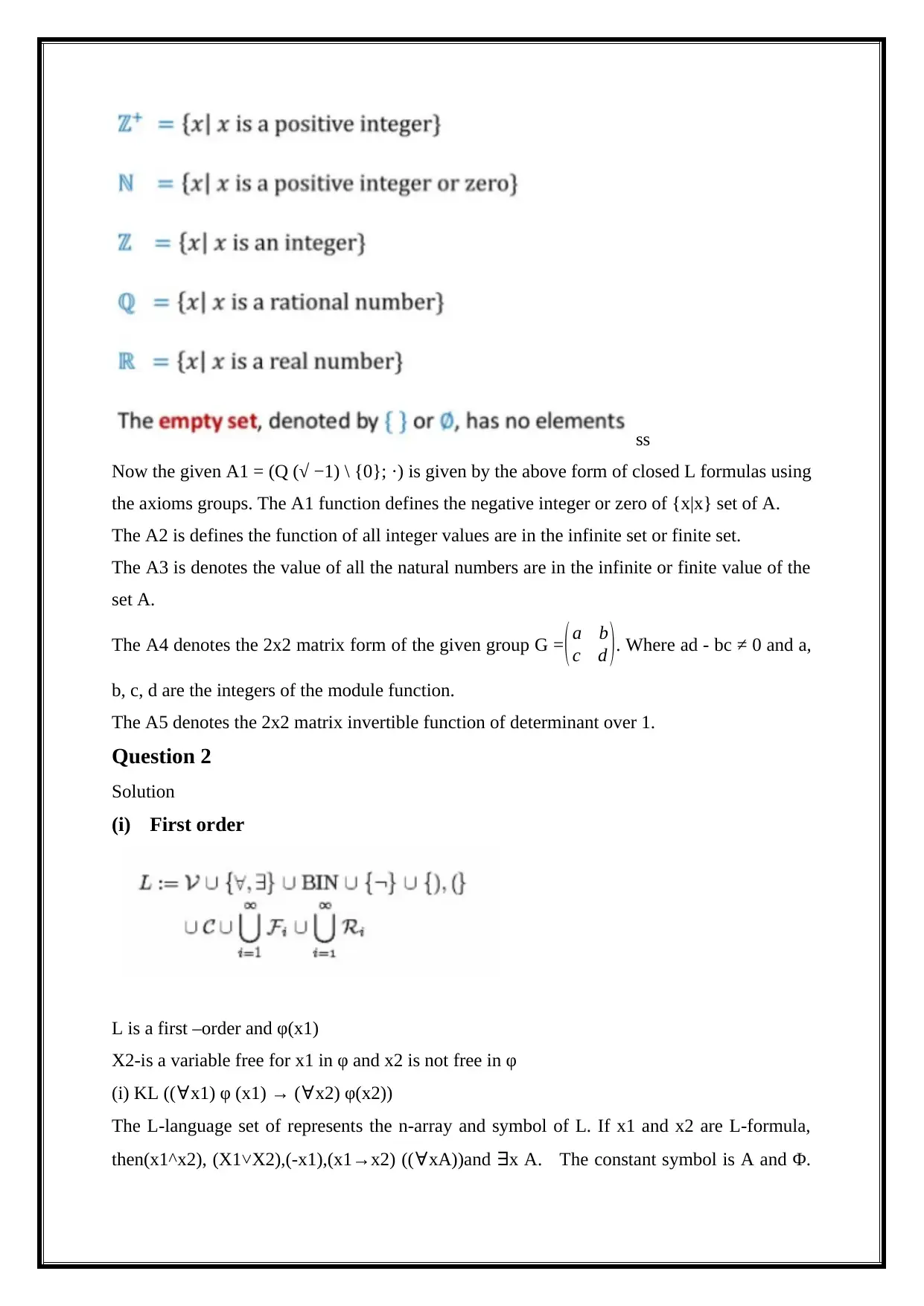
ss
Now the given A1 = (Q (√ −1) \ {0}; ·) is given by the above form of closed L formulas using
the axioms groups. The A1 function defines the negative integer or zero of {x|x} set of A.
The A2 is defines the function of all integer values are in the infinite set or finite set.
The A3 is denotes the value of all the natural numbers are in the infinite or finite value of the
set A.
The A4 denotes the 2x2 matrix form of the given group G = ( a b
c d ). Where ad - bc ≠ 0 and a,
b, c, d are the integers of the module function.
The A5 denotes the 2x2 matrix invertible function of determinant over 1.
Question 2
Solution
(i) First order
L is a first –order and φ(x1)
X2-is a variable free for x1 in φ and x2 is not free in φ
(i) KL ((∀x1) φ (x1) → (∀x2) φ(x2))
The L-language set of represents the n-array and symbol of L. If x1 and x2 are L-formula,
then(x1^x2), (X1˅X2),(-x1),(x1→x2) ((∀xA))and ∃x A. The constant symbol is A and Φ.
Now the given A1 = (Q (√ −1) \ {0}; ·) is given by the above form of closed L formulas using
the axioms groups. The A1 function defines the negative integer or zero of {x|x} set of A.
The A2 is defines the function of all integer values are in the infinite set or finite set.
The A3 is denotes the value of all the natural numbers are in the infinite or finite value of the
set A.
The A4 denotes the 2x2 matrix form of the given group G = ( a b
c d ). Where ad - bc ≠ 0 and a,
b, c, d are the integers of the module function.
The A5 denotes the 2x2 matrix invertible function of determinant over 1.
Question 2
Solution
(i) First order
L is a first –order and φ(x1)
X2-is a variable free for x1 in φ and x2 is not free in φ
(i) KL ((∀x1) φ (x1) → (∀x2) φ(x2))
The L-language set of represents the n-array and symbol of L. If x1 and x2 are L-formula,
then(x1^x2), (X1˅X2),(-x1),(x1→x2) ((∀xA))and ∃x A. The constant symbol is A and Φ.
Paraphrase This Document
Need a fresh take? Get an instant paraphrase of this document with our AI Paraphraser
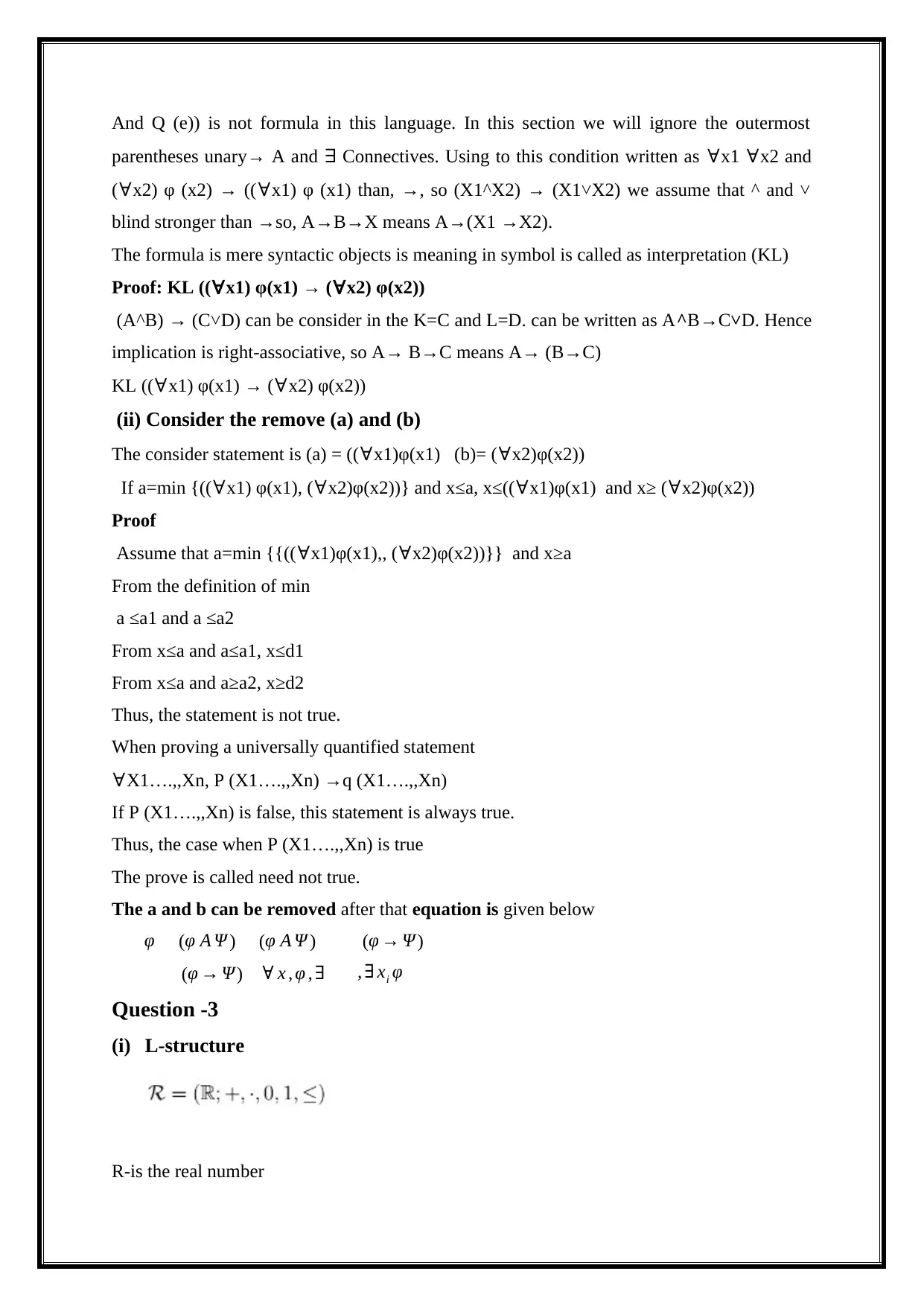
And Q (e)) is not formula in this language. In this section we will ignore the outermost
parentheses unary→ A and ∃ Connectives. Using to this condition written as ∀x1 ∀x2 and
(∀x2) φ (x2) → ((∀x1) φ (x1) than, →, so (X1^X2) → (X1˅X2) we assume that ^ and ˅
blind stronger than →so, A→B→X means A→(X1 →X2).
The formula is mere syntactic objects is meaning in symbol is called as interpretation (KL)
Proof: KL ((∀x1) φ(x1) → (∀x2) φ(x2))
(A^B) → (C˅D) can be consider in the K=C and L=D. can be written as A^B→C˅D. Hence
implication is right-associative, so A→ B→C means A→ (B→C)
KL ((∀x1) φ(x1) → (∀x2) φ(x2))
(ii) Consider the remove (a) and (b)
The consider statement is (a) = ((∀x1)φ(x1) (b)= (∀x2)φ(x2))
If a=min {((∀x1) φ(x1), (∀x2)φ(x2))} and x≤a, x≤((∀x1)φ(x1) and x≥ (∀x2)φ(x2))
Proof
Assume that a=min {{((∀x1)φ(x1),, (∀x2)φ(x2))}} and x≥a
From the definition of min
a ≤a1 and a ≤a2
From x≤a and a≤a1, x≤d1
From x≤a and a≥a2, x≥d2
Thus, the statement is not true.
When proving a universally quantified statement
∀X1….,,Xn, P (X1….,,Xn) →q (X1….,,Xn)
If P (X1….,,Xn) is false, this statement is always true.
Thus, the case when P (X1….,,Xn) is true
The prove is called need not true.
The a and b can be removed after that equation is given below
φ (φ A Ψ ) (φ A Ψ ) (φ → Ψ )
(φ → Ψ ) ∀ x , φ , ∃ , ∃ xi φ
Question -3
(i) L-structure
R-is the real number
parentheses unary→ A and ∃ Connectives. Using to this condition written as ∀x1 ∀x2 and
(∀x2) φ (x2) → ((∀x1) φ (x1) than, →, so (X1^X2) → (X1˅X2) we assume that ^ and ˅
blind stronger than →so, A→B→X means A→(X1 →X2).
The formula is mere syntactic objects is meaning in symbol is called as interpretation (KL)
Proof: KL ((∀x1) φ(x1) → (∀x2) φ(x2))
(A^B) → (C˅D) can be consider in the K=C and L=D. can be written as A^B→C˅D. Hence
implication is right-associative, so A→ B→C means A→ (B→C)
KL ((∀x1) φ(x1) → (∀x2) φ(x2))
(ii) Consider the remove (a) and (b)
The consider statement is (a) = ((∀x1)φ(x1) (b)= (∀x2)φ(x2))
If a=min {((∀x1) φ(x1), (∀x2)φ(x2))} and x≤a, x≤((∀x1)φ(x1) and x≥ (∀x2)φ(x2))
Proof
Assume that a=min {{((∀x1)φ(x1),, (∀x2)φ(x2))}} and x≥a
From the definition of min
a ≤a1 and a ≤a2
From x≤a and a≤a1, x≤d1
From x≤a and a≥a2, x≥d2
Thus, the statement is not true.
When proving a universally quantified statement
∀X1….,,Xn, P (X1….,,Xn) →q (X1….,,Xn)
If P (X1….,,Xn) is false, this statement is always true.
Thus, the case when P (X1….,,Xn) is true
The prove is called need not true.
The a and b can be removed after that equation is given below
φ (φ A Ψ ) (φ A Ψ ) (φ → Ψ )
(φ → Ψ ) ∀ x , φ , ∃ , ∃ xi φ
Question -3
(i) L-structure
R-is the real number
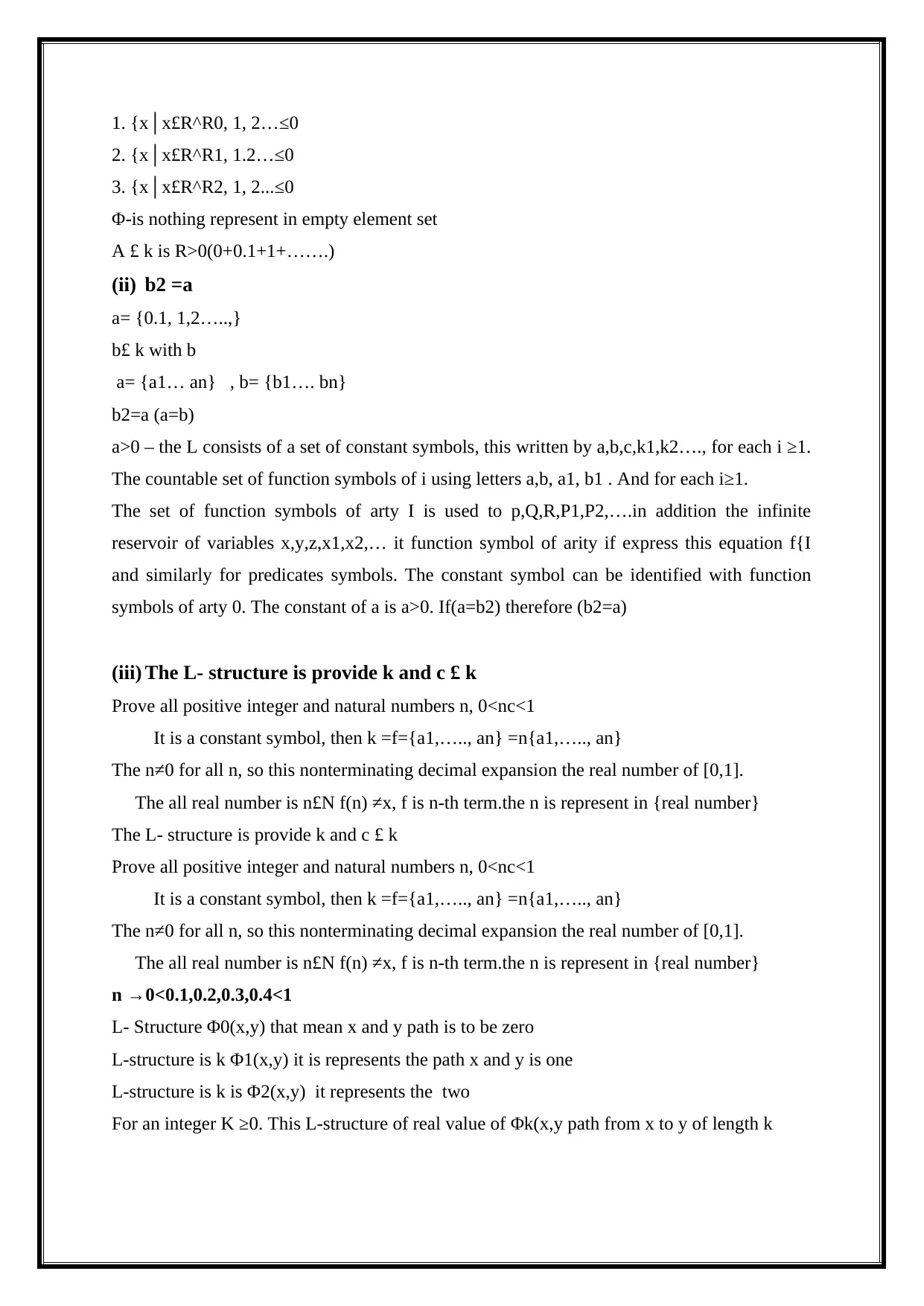
1. {x│x£R^R0, 1, 2…≤0
2. {x│x£R^R1, 1.2…≤0
3. {x│x£R^R2, 1, 2...≤0
Φ-is nothing represent in empty element set
A £ k is R>0(0+0.1+1+…….)
(ii) b2 =a
a= {0.1, 1,2…..,}
b£ k with b
a= {a1… an} , b= {b1…. bn}
b2=a (a=b)
a>0 – the L consists of a set of constant symbols, this written by a,b,c,k1,k2…., for each i ≥1.
The countable set of function symbols of i using letters a,b, a1, b1 . And for each i≥1.
The set of function symbols of arty I is used to p,Q,R,P1,P2,….in addition the infinite
reservoir of variables x,y,z,x1,x2,… it function symbol of arity if express this equation f{I
and similarly for predicates symbols. The constant symbol can be identified with function
symbols of arty 0. The constant of a is a>0. If(a=b2) therefore (b2=a)
(iii) The L- structure is provide k and c £ k
Prove all positive integer and natural numbers n, 0<nc<1
It is a constant symbol, then k =f={a1,….., an} =n{a1,….., an}
The n≠0 for all n, so this nonterminating decimal expansion the real number of [0,1].
The all real number is n£N f(n) ≠x, f is n-th term.the n is represent in {real number}
The L- structure is provide k and c £ k
Prove all positive integer and natural numbers n, 0<nc<1
It is a constant symbol, then k =f={a1,….., an} =n{a1,….., an}
The n≠0 for all n, so this nonterminating decimal expansion the real number of [0,1].
The all real number is n£N f(n) ≠x, f is n-th term.the n is represent in {real number}
n →0<0.1,0.2,0.3,0.4<1
L- Structure Φ0(x,y) that mean x and y path is to be zero
L-structure is k Φ1(x,y) it is represents the path x and y is one
L-structure is k is Φ2(x,y) it represents the two
For an integer K ≥0. This L-structure of real value of Φk(x,y path from x to y of length k
2. {x│x£R^R1, 1.2…≤0
3. {x│x£R^R2, 1, 2...≤0
Φ-is nothing represent in empty element set
A £ k is R>0(0+0.1+1+…….)
(ii) b2 =a
a= {0.1, 1,2…..,}
b£ k with b
a= {a1… an} , b= {b1…. bn}
b2=a (a=b)
a>0 – the L consists of a set of constant symbols, this written by a,b,c,k1,k2…., for each i ≥1.
The countable set of function symbols of i using letters a,b, a1, b1 . And for each i≥1.
The set of function symbols of arty I is used to p,Q,R,P1,P2,….in addition the infinite
reservoir of variables x,y,z,x1,x2,… it function symbol of arity if express this equation f{I
and similarly for predicates symbols. The constant symbol can be identified with function
symbols of arty 0. The constant of a is a>0. If(a=b2) therefore (b2=a)
(iii) The L- structure is provide k and c £ k
Prove all positive integer and natural numbers n, 0<nc<1
It is a constant symbol, then k =f={a1,….., an} =n{a1,….., an}
The n≠0 for all n, so this nonterminating decimal expansion the real number of [0,1].
The all real number is n£N f(n) ≠x, f is n-th term.the n is represent in {real number}
The L- structure is provide k and c £ k
Prove all positive integer and natural numbers n, 0<nc<1
It is a constant symbol, then k =f={a1,….., an} =n{a1,….., an}
The n≠0 for all n, so this nonterminating decimal expansion the real number of [0,1].
The all real number is n£N f(n) ≠x, f is n-th term.the n is represent in {real number}
n →0<0.1,0.2,0.3,0.4<1
L- Structure Φ0(x,y) that mean x and y path is to be zero
L-structure is k Φ1(x,y) it is represents the path x and y is one
L-structure is k is Φ2(x,y) it represents the two
For an integer K ≥0. This L-structure of real value of Φk(x,y path from x to y of length k
⊘ This is a preview!⊘
Do you want full access?
Subscribe today to unlock all pages.

Trusted by 1+ million students worldwide
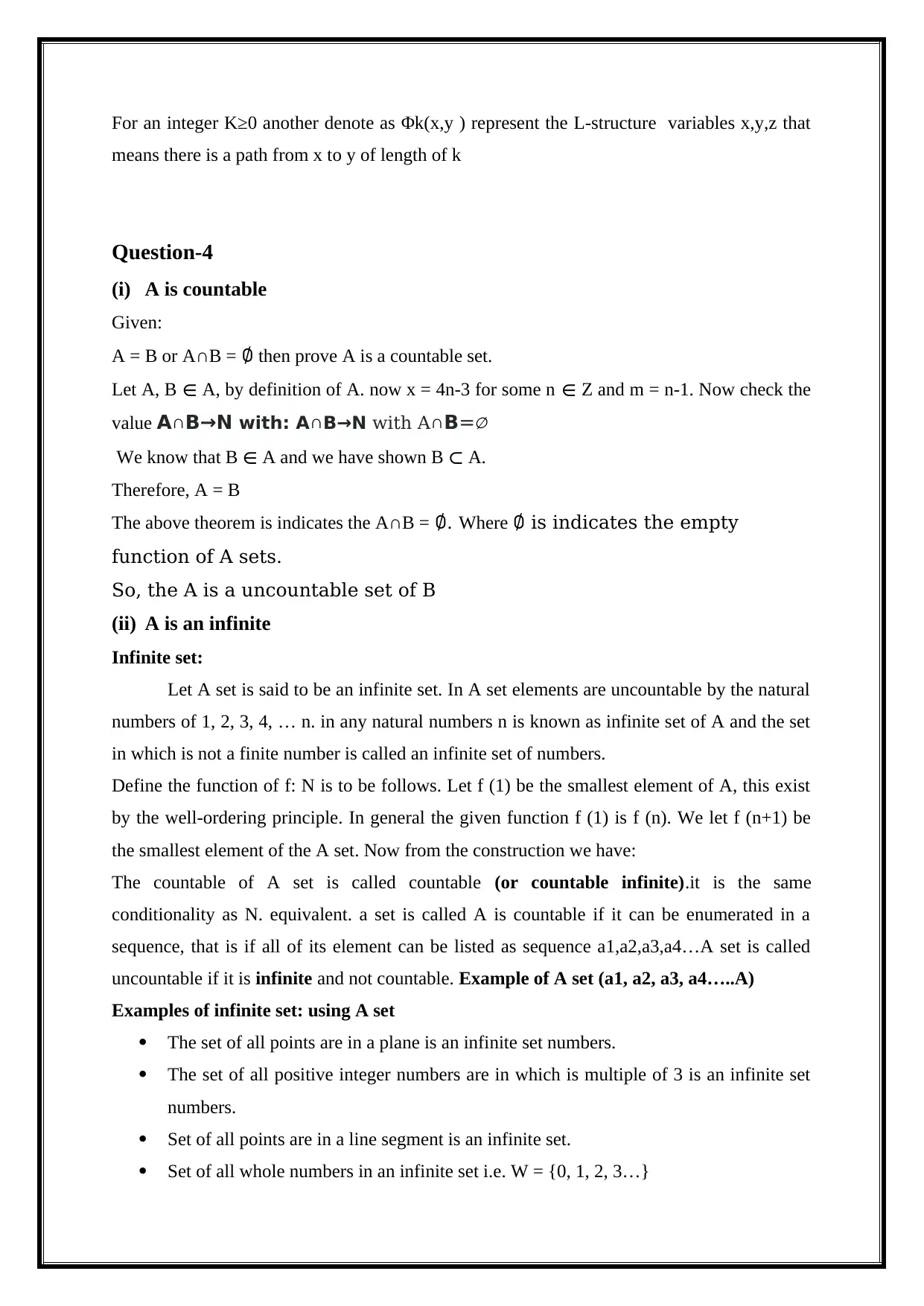
For an integer K≥0 another denote as Φk(x,y ) represent the L-structure variables x,y,z that
means there is a path from x to y of length of k
Question-4
(i) A is countable
Given:
A = B or A∩B = ∅ then prove A is a countable set.
Let A, B ∈ A, by definition of A. now x = 4n-3 for some n ∈ Z and m = n-1. Now check the
value A∩B→N with: A∩B→N with A∩B=∅
We know that B ∈ A and we have shown B ⊂ A.
Therefore, A = B
The above theorem is indicates the A∩B = ∅. Where ∅ is indicates the empty
function of A sets.
So, the A is a uncountable set of B
(ii) A is an infinite
Infinite set:
Let A set is said to be an infinite set. In A set elements are uncountable by the natural
numbers of 1, 2, 3, 4, … n. in any natural numbers n is known as infinite set of A and the set
in which is not a finite number is called an infinite set of numbers.
Define the function of f: N is to be follows. Let f (1) be the smallest element of A, this exist
by the well-ordering principle. In general the given function f (1) is f (n). We let f (n+1) be
the smallest element of the A set. Now from the construction we have:
The countable of A set is called countable (or countable infinite).it is the same
conditionality as N. equivalent. a set is called A is countable if it can be enumerated in a
sequence, that is if all of its element can be listed as sequence a1,a2,a3,a4…A set is called
uncountable if it is infinite and not countable. Example of A set (a1, a2, a3, a4…..A)
Examples of infinite set: using A set
The set of all points are in a plane is an infinite set numbers.
The set of all positive integer numbers are in which is multiple of 3 is an infinite set
numbers.
Set of all points are in a line segment is an infinite set.
Set of all whole numbers in an infinite set i.e. W = {0, 1, 2, 3…}
means there is a path from x to y of length of k
Question-4
(i) A is countable
Given:
A = B or A∩B = ∅ then prove A is a countable set.
Let A, B ∈ A, by definition of A. now x = 4n-3 for some n ∈ Z and m = n-1. Now check the
value A∩B→N with: A∩B→N with A∩B=∅
We know that B ∈ A and we have shown B ⊂ A.
Therefore, A = B
The above theorem is indicates the A∩B = ∅. Where ∅ is indicates the empty
function of A sets.
So, the A is a uncountable set of B
(ii) A is an infinite
Infinite set:
Let A set is said to be an infinite set. In A set elements are uncountable by the natural
numbers of 1, 2, 3, 4, … n. in any natural numbers n is known as infinite set of A and the set
in which is not a finite number is called an infinite set of numbers.
Define the function of f: N is to be follows. Let f (1) be the smallest element of A, this exist
by the well-ordering principle. In general the given function f (1) is f (n). We let f (n+1) be
the smallest element of the A set. Now from the construction we have:
The countable of A set is called countable (or countable infinite).it is the same
conditionality as N. equivalent. a set is called A is countable if it can be enumerated in a
sequence, that is if all of its element can be listed as sequence a1,a2,a3,a4…A set is called
uncountable if it is infinite and not countable. Example of A set (a1, a2, a3, a4…..A)
Examples of infinite set: using A set
The set of all points are in a plane is an infinite set numbers.
The set of all positive integer numbers are in which is multiple of 3 is an infinite set
numbers.
Set of all points are in a line segment is an infinite set.
Set of all whole numbers in an infinite set i.e. W = {0, 1, 2, 3…}
Paraphrase This Document
Need a fresh take? Get an instant paraphrase of this document with our AI Paraphraser
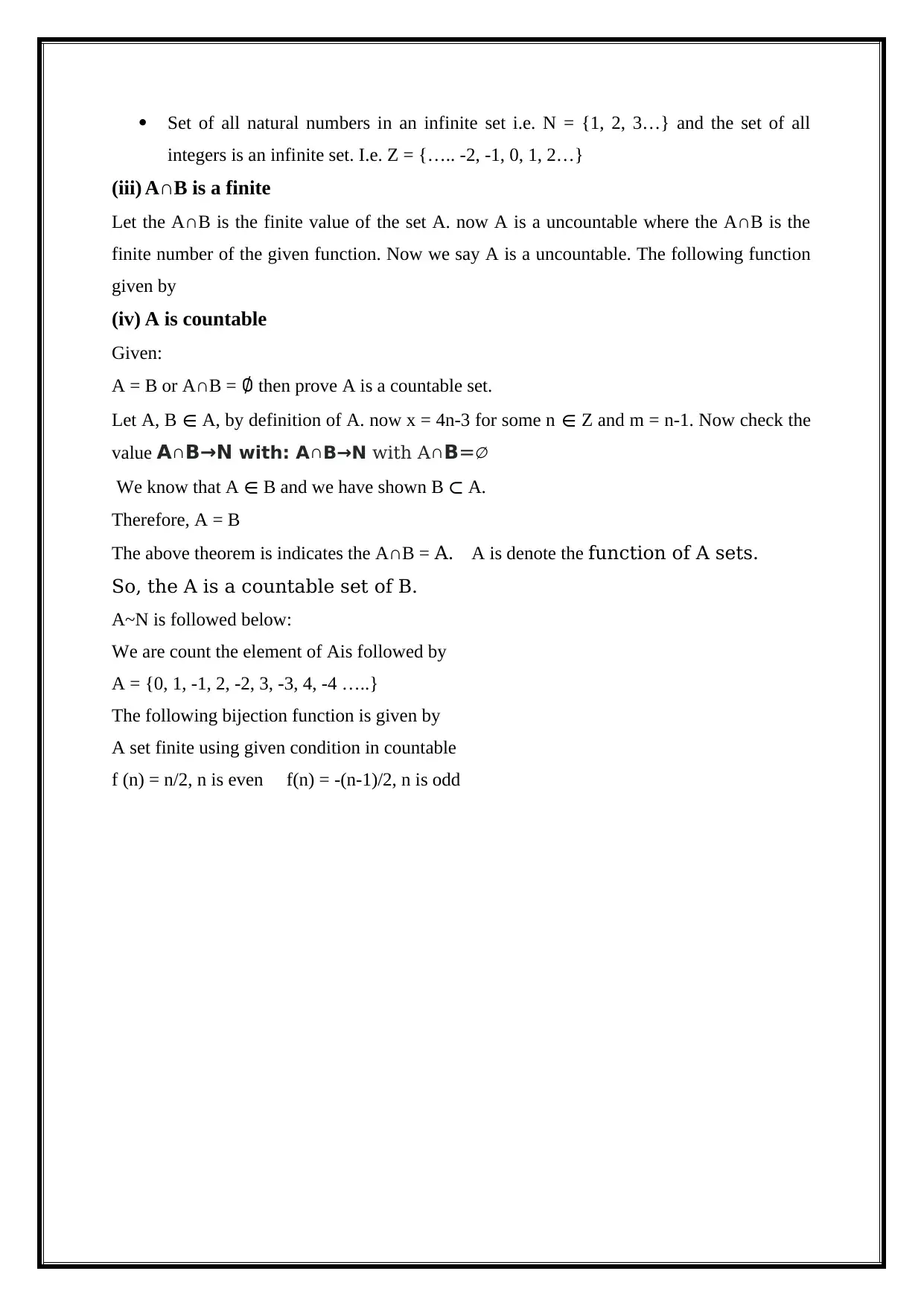
Set of all natural numbers in an infinite set i.e. N = {1, 2, 3…} and the set of all
integers is an infinite set. I.e. Z = {….. -2, -1, 0, 1, 2…}
(iii) A∩B is a finite
Let the A∩B is the finite value of the set A. now A is a uncountable where the A∩B is the
finite number of the given function. Now we say A is a uncountable. The following function
given by
(iv) A is countable
Given:
A = B or A∩B = ∅ then prove A is a countable set.
Let A, B ∈ A, by definition of A. now x = 4n-3 for some n ∈ Z and m = n-1. Now check the
value A∩B→N with: A∩B→N with A∩B=∅
We know that A ∈ B and we have shown B ⊂ A.
Therefore, A = B
The above theorem is indicates the A∩B = A. A is denote the function of A sets.
So, the A is a countable set of B.
A~N is followed below:
We are count the element of Ais followed by
A = {0, 1, -1, 2, -2, 3, -3, 4, -4 …..}
The following bijection function is given by
A set finite using given condition in countable
f (n) = n/2, n is even f(n) = -(n-1)/2, n is odd
integers is an infinite set. I.e. Z = {….. -2, -1, 0, 1, 2…}
(iii) A∩B is a finite
Let the A∩B is the finite value of the set A. now A is a uncountable where the A∩B is the
finite number of the given function. Now we say A is a uncountable. The following function
given by
(iv) A is countable
Given:
A = B or A∩B = ∅ then prove A is a countable set.
Let A, B ∈ A, by definition of A. now x = 4n-3 for some n ∈ Z and m = n-1. Now check the
value A∩B→N with: A∩B→N with A∩B=∅
We know that A ∈ B and we have shown B ⊂ A.
Therefore, A = B
The above theorem is indicates the A∩B = A. A is denote the function of A sets.
So, the A is a countable set of B.
A~N is followed below:
We are count the element of Ais followed by
A = {0, 1, -1, 2, -2, 3, -3, 4, -4 …..}
The following bijection function is given by
A set finite using given condition in countable
f (n) = n/2, n is even f(n) = -(n-1)/2, n is odd
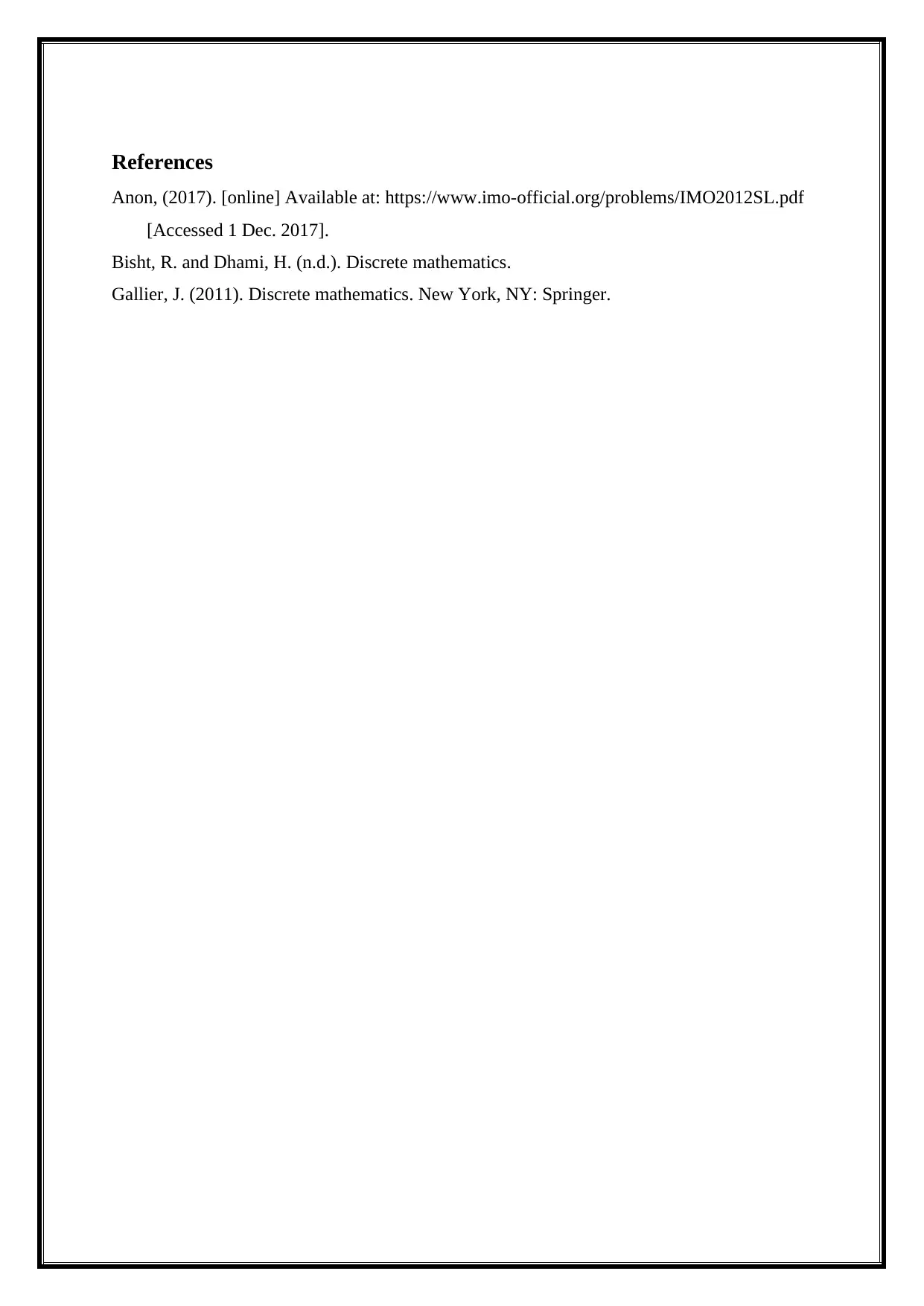
References
Anon, (2017). [online] Available at: https://www.imo-official.org/problems/IMO2012SL.pdf
[Accessed 1 Dec. 2017].
Bisht, R. and Dhami, H. (n.d.). Discrete mathematics.
Gallier, J. (2011). Discrete mathematics. New York, NY: Springer.
Anon, (2017). [online] Available at: https://www.imo-official.org/problems/IMO2012SL.pdf
[Accessed 1 Dec. 2017].
Bisht, R. and Dhami, H. (n.d.). Discrete mathematics.
Gallier, J. (2011). Discrete mathematics. New York, NY: Springer.
⊘ This is a preview!⊘
Do you want full access?
Subscribe today to unlock all pages.

Trusted by 1+ million students worldwide
1 out of 9
Your All-in-One AI-Powered Toolkit for Academic Success.
+13062052269
info@desklib.com
Available 24*7 on WhatsApp / Email
![[object Object]](/_next/static/media/star-bottom.7253800d.svg)
Unlock your academic potential
Copyright © 2020–2025 A2Z Services. All Rights Reserved. Developed and managed by ZUCOL.
